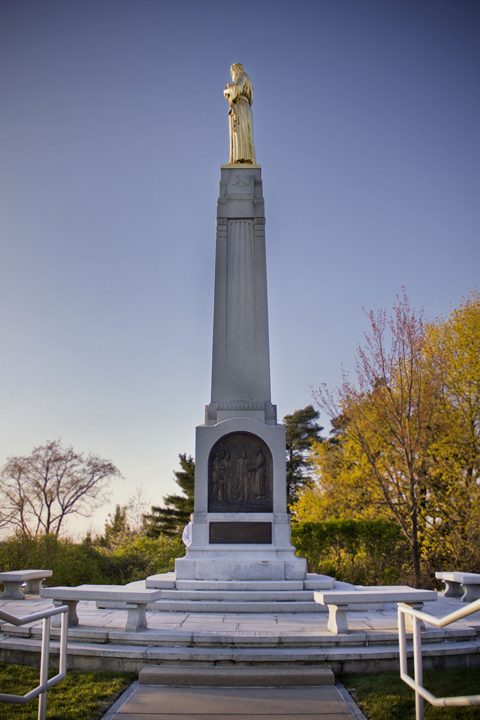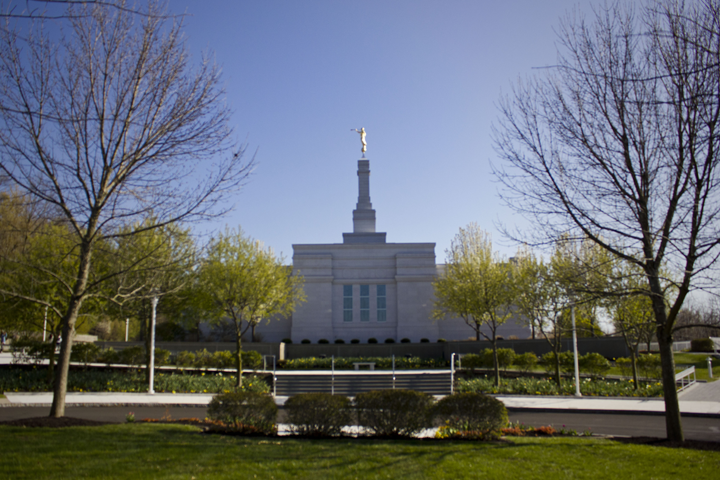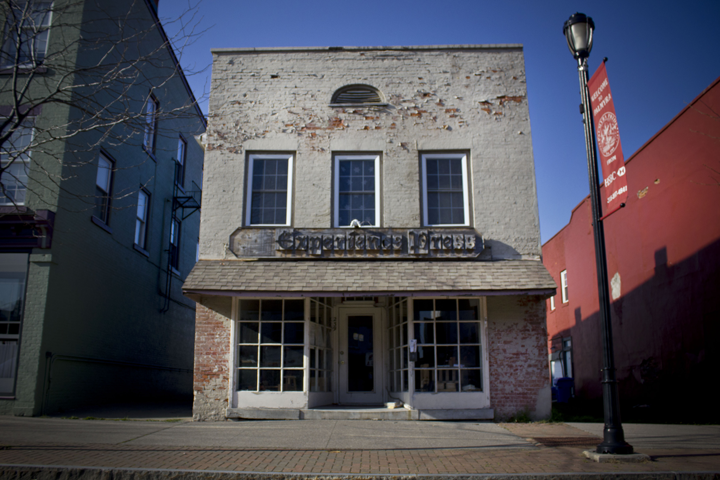Latter Day: A pilgrimage to Mormonism's birth place
Story by Zoë Mintz Photos by Meg O'Malley
In February, a researcher discovered that a Mormon church in the Dominican Republic posthumously baptized Anne Frank into its faith. As a Jew who’s visited concentration camps, I felt offended. Anne Frank— who died because of her Jewish faith—a baptized Mormon? But ignorance breeds hatred, so I decided to venture to nearby Palmyra, N.Y., the birthplace of Mormonism. I needed a sidekick though. So I asked my roommate Lela, an evangelical Christian, to come along. The night before our trip, we watched a four-hour PBS documentary about the religion. We learned the Church of Jesus Christ of Latter-day Saints (short- handed as LDS) reasoned that baptizing nonbelievers after they’d died would enable their souls to enter “God’s Kingdom.”
The Mormon Church has a genealogical database called familysearch.org, containing 2 billion names taken from government census data. Today the database acts as a free public online resource but also has a Mormon-members-only counterpart, indicating if someone’s been baptized yet. Mormons use the site to find names, which pop up on a computer screen in front of a temple pool as baptism candidates are dunked. The ultimate goal is to convert as many living and dead as possible.
We paused the film so we could log onto the site. Lela typed in the name of her great- grandmother, Lucille Colbert, a Southerner with no connection to Mormonism. But her name still came up in the search queries filling the screen. On the rightmost column, under “children,” she pointed out her grandmother’s name. Lela burst into tears, sobbing at the idea of the Mormon “cult,” as she referred to the religion after the PBS doc, posthumously baptizing her great-grandmother. I wasn’t sure if she’d still come with me.
Lela was saved two years ago. She went from being a “huge social liberal” who rejected marriage to wanting a Duggar-sized family and living by literal biblical principles. “The idea of submitting to my husband would have made me vomit,” she told me. “Now it makes me rejoice.” I’m not as devout. To fast, I eat less. On Passover, I add matzo to my diet without eliminating much else. But despitethis,I’mpassionateaboutmyJewish tradition. I’ve visited concentration camps in Poland and been to Israel four times; my 19-year-old cousin is an officer in the Israeli navy. And despite our differences, Lela and I share a profound interest in other religions.
All religions have miracles (the burning bush or Jesus walking on water) but something about bringing a biblical religion into American history—saying the Garden of Eden is in Missouri and believing Native Americans descend from an ancient Israelite tribe—by way of a 14-year-old seemed so far- fetched and, well, unbelievable. I wanted to know, “Why do people believe in this?”
On a spring day in 1820, a 14-year-old boy named Joseph Smith had a vision of God and Jesus in a grove near his home in Palmyra. Three years later, in his bedroom he saw an angel who called on him to go to a nearby hill and dig up a set of golden tablets with holy writings on them. He did as he was told. Within a few years, Smith translated the writings on the plates, which became the Book of Mormon.
The following morning, a Sunday, Lela and I drank our favoriteTim Hortons coffees and jammed to Broadway’s The Book of Mormon soundtrack as we headed to Palmyra, an hour’s drive west of Syracuse. We first visited the Smith family’s log home. Metal plates, cutlery, and mugs adorned the dining room table. Glass encased the original family Bible. We followed Sister Raines, a 21-year-old missionary and our tour guide. Lela and I referred to her as the “down-to-earth missionary.” Nothing she said sounded scripted, embellished, or dumbed down. Her candor prompted me to mention the Holocaust victims and the posthumous baptisms. She assured me the church didn’t mean to offend anyone by it. She said they’re just giving souls a chance to embrace the Mormon gospel, adding, “If someone danced on the graves of my dead relatives I wouldn’t have a problem with it.”
She led Lela and I up the narrow wooden staircase to Joseph Smith’s bedroom, which he shared with his eight siblings. Light poured out of a small window just above Smith’s bed, where Mormons believe Moroni, the angel, appeared. Believing the bedroom constituted a sacred space, I hesitated to ask if I could take a picture. “Of course,” Sister Raines said. “There’s nothing you can ask, say, or do that hasn’t been done before.”
I mentioned this moment to Airen Hall, a Ph.D. student at Syracuse University, who wrote her dissertation on contemporary LDS pilgrimages to significant sites like Palmyra. She also practiced Mormonism until age 17. She explained that, unlike other religions, Mormons don’t have a consensus on what is holy. “Mormons place emphasis on personal revelation,” she said. It’s up to the individual's experience and whether they “feel the spirit.” This reminded me of my trip to Israel last summer. I remember an elderly lady at the Church of the Holy Sepulchre in Jerusalem sobbing at Jesus’ tomb. She fell to her knees with a plastic tote bag filled with prayer shawls. Our tour guide speculated that they belonged to her church friends from back home who asked her to rub them on the tomb. A handful of church members walked around the sites visited in Palmyra. None seemed as emotional as the shawl lady.
Although Mormonism emphasizes personalized reverence, most members share a common peace while visiting a Mormon temple. In 2000, the LDS built its 77th temple in Palmyra. It’s bone white. The rectangular windows, geometric shape, and repeating circular pattern along the frieze resemble Frank Lloyd Wright’s organic style. A golden statue of Moroni sits on a pillar, overlooking the temple grounds. Lela and I knew almost nothing about it beside that we weren’t allowed inside. Only Mormons who receive a “temple recommend” from a Mormon bishop can enter. Inside, there’s no traditional praying—only special ceremonies like weddings, endowments, and posthumous baptisms.
When Lela and I walked around the temple, we noticed that every window contained stained glass trees, leaves, and a blue sky to represent the Sacred Grove where Joseph Smith received his first vision, a half- mile away. Days later in a Mormon church in Syracuse, Brittany and Ryan Milcarek remember getting married in the Palmyra Temple in October. They recalled mirrors lining the room that held their ceremony, symbolizing the eternal bond they were committing to. Mimicking its exterior, attendees must remove their street clothes in favor of all-white ensembles. It’s supposed to be the closest thing to heaven on earth.
On that Sunday, the majority of businesses on Main Street were closed, except for Athenia, a bustling diner populated by elderly couples fixated on Brian Williams’ mug on the large flat-screen TVs. But when I started asking about the Mormon community, the hum of Sunday night chatter fell uncomfortably silent. Our
waitress claimed that she neither knew much nor had an opinion about the Mormons. I mentioned this to Bonnie Hays of Historic Palmyra, the local historical society. “I’m not a Mormon, but I think they’re the nicest, kindest, and most generous people I know,” she says. Hays, who’s lived in the town for 42 years, describes Palmyra as “the most accepting place I’ve ever been to. I think it’s always been this way.” The notion echoes parts of Palmyra’s history, which takes root in abolitionism, the temperance movement, women’s rights, and religious revivals (spiritualism was born in Palmyra, too). Palmyra’s “Four Corners” symbolize this history: four churches of different denominations reside at each corner at the intersection of Canadaigua Street and Main Street in the town.
Mormons have a different take. They say nonbelievers drove Joseph Smith and his followers out of Palmyra. “Persecution was basic human behavior,” Hays told me. “It wasn’t good behavior, but it was behavior nonetheless.” Though contention remains over whether or not the first Mormons were persecuted or just “made fun of,” as Jan Shipps, one of the foremost non-Mormon scholars on the LDS, believes. Coming from a religion with a long history of persecution, I can empathize with the Mormons’ sensitivity to the topic. The Mormons established Ufor similar reasons Jews founded Israel. A restaurant patron reminded me that we were visiting the town during its off-season. Palmyra blossoms in July, during the seven- day Hill Cumorah Pageant. Celebrating its 75th anniversary this year, the performance takes place on the hill where Joseph Smith found the golden tablets; the ground seats 8,000. The 700-person cast depicts scenes from the Bible and the Book of Mormon. Thousands of believers make the pilgrimage to either watch or participate. On our way back onto I-90, Lela and I passed the Hill Cumorah and noticed the dilapidated farmhouses and rundown trailer park just a mile or so away from the onramp. I remember a rush of questions streaming through my head. I still understood little. I’d learned a lot about the history, personality, and unwavering faith of Mormons. But, even among the relics and followers, I never got a clear answer on why people believe in the visions of a 14-year- old so deeply. And so Lela plugged in my iPhone, and we started singing along:
You all know the Bible is made of testaments old and new
You've been told it's just those two parts, or only one if you're a Jew
But what if I were to tell you—there's a fresh third part out there
Which was found by a hip new prophet who had a little... Donny Osmond flair?
Read our Web Exclusive Face Time with Marc Clay, Syracuse's stake president for the LDS Church.





